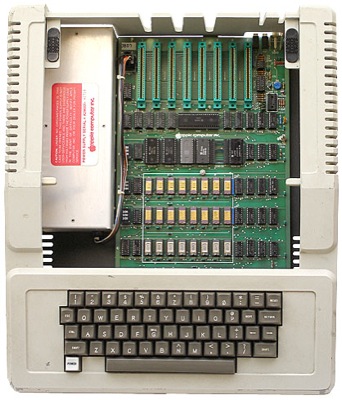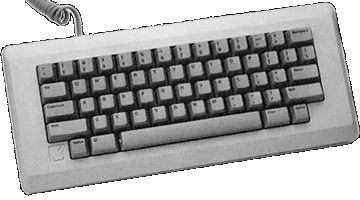Apple ][

Essentials
Family: Pre-Macintosh
Codename: ?
Introduced: April 1977
Terminated: May 1979
Processor
CPU: MOS Technology 6502
CPU Speed: 1 MHz
FPU: none
Bus Speed: 1 MHz
Register Width: 8-bit
Data Bus Width: 8-bit
Address Bus Width: 16-bit
ROM: 12 kB
RAM slots: 1st expansion slot can be used
Expansion Slots: 8 proprietary
Video
Max Resolution: 6 color at 280x192, 4-bit color at 40x48
Storage
Floppy Drive: optional
Input/Output
Serial: optional expansion card
Speaker: mono
Miscellaneous
Dimensions: 4.25" H x 15.25" W x 17.75" D
Weight: 11.5 lbs.

Built in 1977, the Apple ][ was based on Wozniak's Apple I design, but with several additions. The first was the design of a plastic case--a rarity at the time--which was painted beige. The second was the ability to display color graphics--a holy grail in the industry. The Apple ][ also included a larger ROM, more expandable RAM (4K to start), and 8 expansion slots. It had integer BASIC hard-coded on the ROM for easier programming, and included two game paddles and a demo cassette for $1,298. In early 1978 Apple also released a disk drive for the machine, one of the most inexpensive available. The Apple ][ remained on the Apple product list until 1980.
Picture Credits:
Old Computers
Date: Tue, 18 Aug 1998 18:08:00 -0700
From: Bill Dugan
Subject: Apple ][
The Apple II series' 6502 processor could only address 64 kB of memory (both RAM and ROM combined). The ROM was located in the upper 12 kB, including AppleSoft BASIC and the Monitor. There is a clever story about this...
The 64 kB that the 6502 could address was arranged roughly like this:
48 kB: RAM
4 kB: Expansion cards
+12 kB: ROM
------------
64 kB total
So when it came time to introduce RAM expansion cards, what to do? The 6502 was already maxed out, addressing all 64 kB that it could possibly address.
Microsoft used a clever solution in their 16 kB RAM expansion card. Programmers could toggle soft switches to "switch out" the 12 kB of ROM and instead address 12 kB of RAM on the expansion card. Another set of switches would "switch out" 4 kB of the RAM on the expansion card for a second bank of 4 kB RAM.
So, an Apple II+ with a 16 kB RAM expansion card could indeed access 64 kB RAM, but you had to cut off access to the machine's ROM while doing so. Other memory cards appeared (I had a Saturn 128 kB card) that used about the same scheme, with lots and lots of switches to use that upper 12 kB of address space to, tortuously, add more and more memory, 12 kB at a time. The Apple //e's 64 kB expansion board even swapped out the entire address space of the 6502, essentially containing a separate Apple //e mapped out in the expansion board, and you'd flip back and forth between the two if you wanted to use the extra 64 kB.
bill
Date: Tue, 09 Feb 1999 02:02:00 -0800
From: Glen Hoag
Subject: Apple II
The 16 kB RAM card, which Bill Dugan credits to Microsoft, was originally designed by Apple, in order to support the UCSD P-system, aka Apple Pascal. Perhaps Mr. Dugan is thinking of Microsoft's CP/M Softcard, which contained a Z-80 microprocessor, and allowed the Apple to run software written for the Digital Research CP/M operating system, though it's possible that Microsoft made a knockoff of Apple's card. Many clones were available, as the Apple card was initially available only with the Pascal software.
Date: Tue, 03 Feb 2004 01:02:07 -0800
From: Anonymous
Subject: ITT2020 - Apple II produced in license in UK
Just wanted to attract your attention that here, in Europe, ITT Great-Britain manufactured the twin brother of the Apple II, the ITT2020 under license agreement of Apple. As Apple only started up its production, and they were struggling with manufacturing capacity because of the booming demand, these things were sold in Europe before the genuine Apple II hit the European market.
The peculiar thing about the ITT2020 is that it's British, so it had to be at least a little bit incompatible in one way or another. Whereas Apple II worked with 8 bits, the ITT2020 worked with 9. This had in fact increadibly little impact in day to day use of normal Apple II software, but especially the installation of a new extension board was always a risky business, as it might/might not/might from time to time not work because of the ninth bit...
It's the ITT2020 that stimulated me back then to experiment with computers, and this itch still lives on today.
So I'm not at all reporting a mistake, but I guess one could almost call it an omission; something that could be mentioned for the sake of giving a complete picture of the history of Apple.
Should you decide to take this information onboard, I have the original ITT2020 in my basement; just in case...
Date: Tue, 02 Aug 2005 19:08:56 -0700
From: Antonio Rodríguez
Subject: Apple ][
The initial ROM was only 8 Kb. It included the Monitor (the Apple]['s basic ROM-based OS), Woz's Integer Basic, and some utilities and routines, like a simple assembler. The motherboard had also two ROM sockets, each of which could be filled with a 2 Kb ROM chip, giving a total of 12 Kb if both sockets were used. Many Apple ][s were shipped with Apple's Programmer's Aids #1 in socket 1 (which offered, among other things, music and high-resolution graphics routines and the Sweet-16 16-bit virtual machine interpreter), but no chip for the second socket became popular.
The initial RAM was only 4 Kb. The computer had to be expanded to at least 16 Kb in order to being able of doing high resolution graphics.
The first revision of the motherboard could display only 4 colors in high resolution. Then, Woz realized that an small trick would enable it to display two more colors, and revision B boards supported all 6 colors.
Date: Fri, 31 Mar 2006 04:03:16 -0800
From: Dave Jewell
Subject: The ITT 2020
With reference to the entry for the Apple II, "Anonymous" states that: "Whereas Apple II worked with 8 bits, the ITT2020 worked with 9".
This not strictly accurate. As with every other 6502-based microcomputer that's ever existed, the ITT 2020 used 8 bits per byte. If it hadn't, it would have been a very strange beast indeed!
However, the ITT2020 was designed to produce a PAL video signal for the European market, as against an NTSC for the domestic US market. This required changes to Wozniak's video generation circuitry such that the ITT2020 actually had to display more horizontal pixels in hi-res video mode. To achieve this, the memory-mapped video buffer had a hidden "ninth bit" associated with each byte. This is the only sense in which a ninth bit was used.
I was one of the original engineers in the ITT2020 team, based at ITT Consumer Products, Basildon, Essex, back in 1979.
Hope this is of interest!
Best regards,
Dave Jewell
Date: Tue, 21 Nov 2006 02:11:44 -0800
From: Tony Life
Subject: Apple ][ v ITT video
If my memory serves me well, the Apple ][ used 7 out of eight bits per byte for pixels with the eighth used for phase to select the colours of the seven bits. The ITT 2020 used all 8 bits for pixels with the ninth supplied from an additional RAM chip. The bits represented alternate colours to make up white.
Date: Mon, 20 Apr 2009 09:11:06 -0700
From: David Edmondson
Subject: More on ITT2020 graphics
The upshot of the ITT2020 graphics differences was that games not written in Basic had vertical stripes down the screen. It was possible to fit a switch that selected between Apple ][ graphics or ITT 2020 graphics so games could be de-glitched.
Date: Fri, 02 Apr 2010 09:37:43 -0700
From: Mark Sienkiewicz
Subject: Apple II
The original Apple ][ came with Woz's "Integer BASIC" in ROM.
Later, they released "Applesoft BASIC" and then "Applesoft II". Applesoft was Microsoft Basic adapted to the Apple. You could load it from cassette tape.
You could also buy Applesoft II in ROM on a plug-in card for slot 0. (Slot 0 had a pin that could disable the on-board ROMs.)
When they made Pascal for the Apple II, Apple build a memory card that you could plug into slot 0. The boot process would load the Pascal code into that memory, then write-protect it. The effect is that you could load your "ROM" from the disk. At one point, Microsoft did make a clone of this card.
Some games loaded special software into this "ROM" as a copy protection measure, but there was a trivial hardware mod that you could use to enable/disable the card with a switch. i.e. Boot the game, flip the switch to disable the "ROM", and press reset, then examine the code in memory.
The high resolution graphics (280x192) were only 4 colors in the Apple II - white/black/sort of green/sort of red - but there was an article in Byte magazine about how you could change the colors by playing with the tint knob on your television. Only 7 bits of each byte were used in hires graphics, so Woz wrote in to Byte showing a circuit that would use the 8th bit to phase shift all 7 pixels in that byte, causing the green/red to turn into blue/orange for that byte.
That hack would easily fit into the small breadboard area on the Apple II motherboard, but it was built in to the Apple II+, which therefore did have 6 colors in hires graphics.
